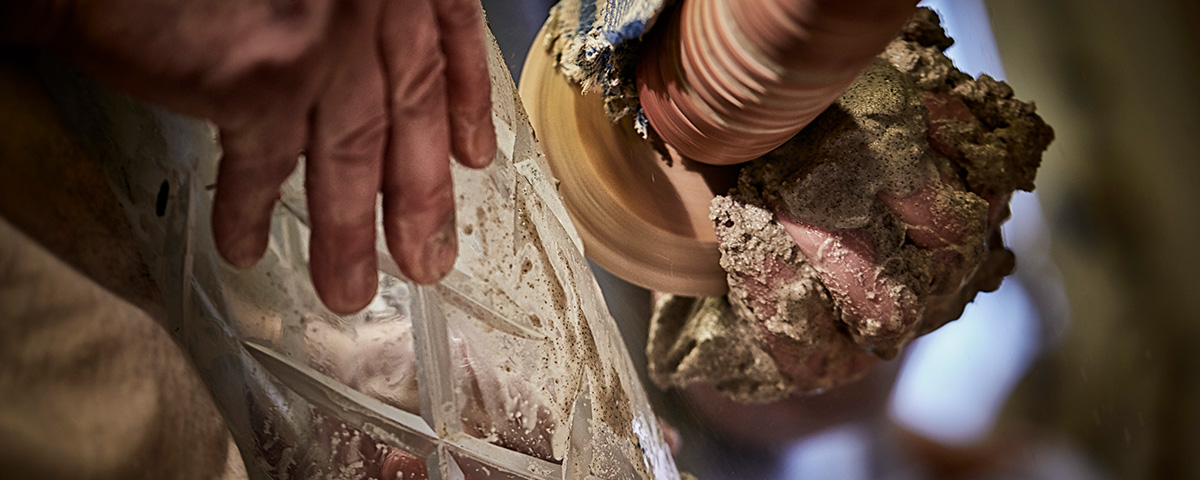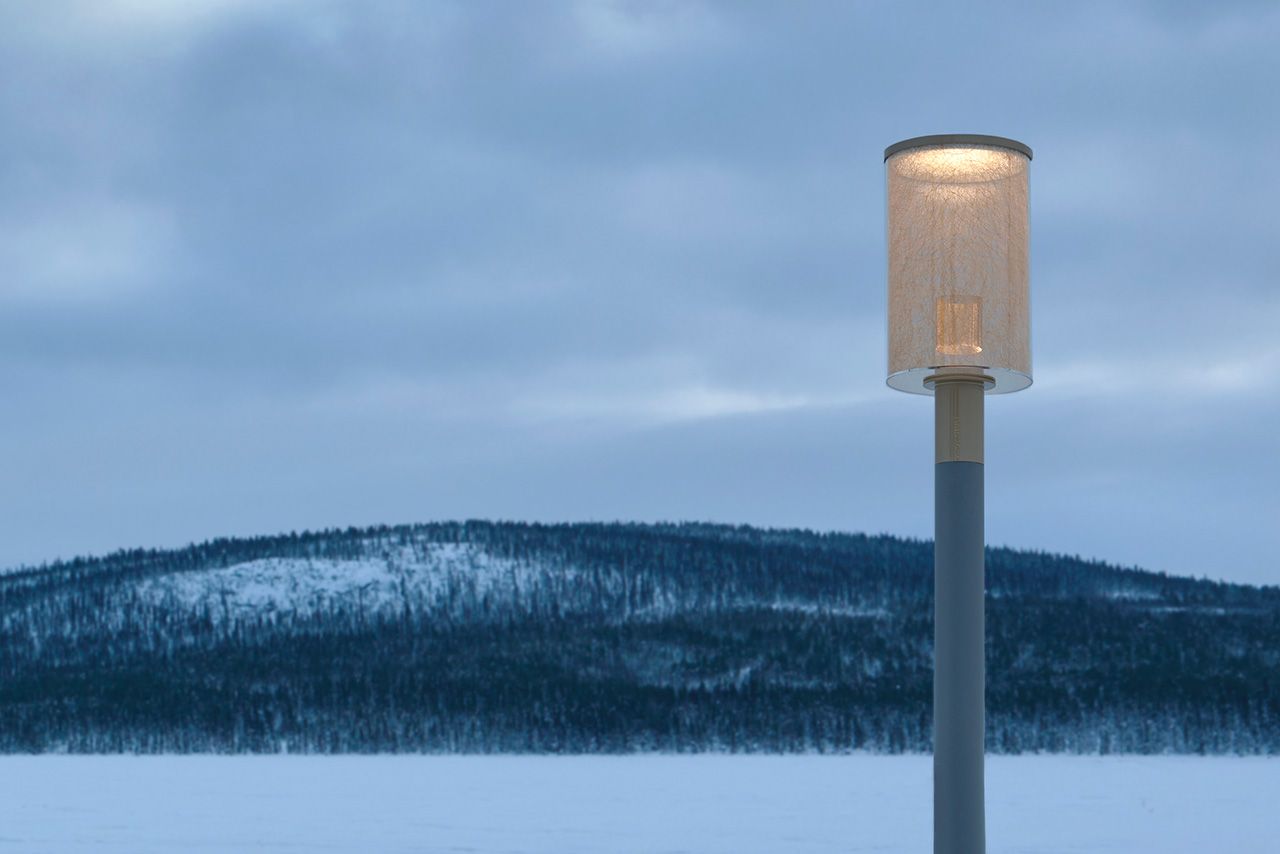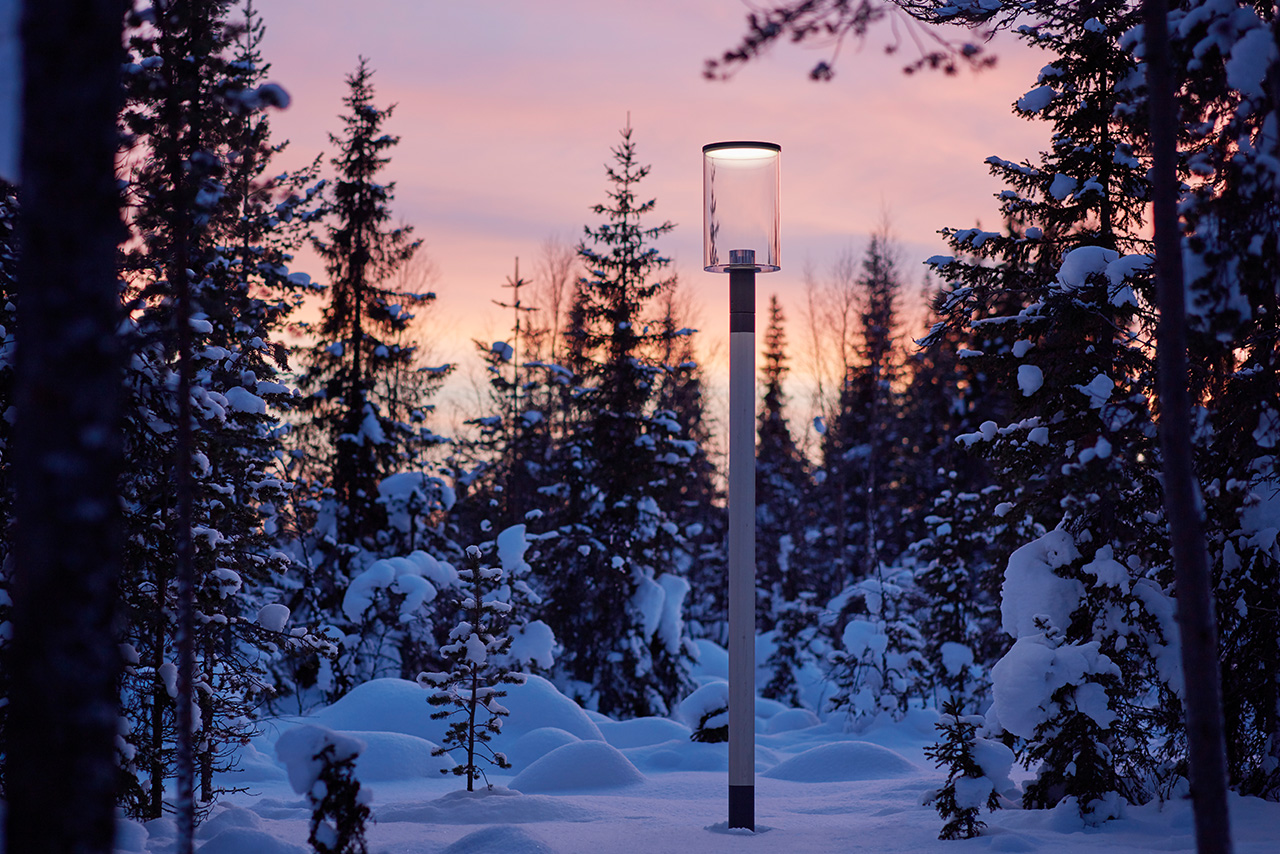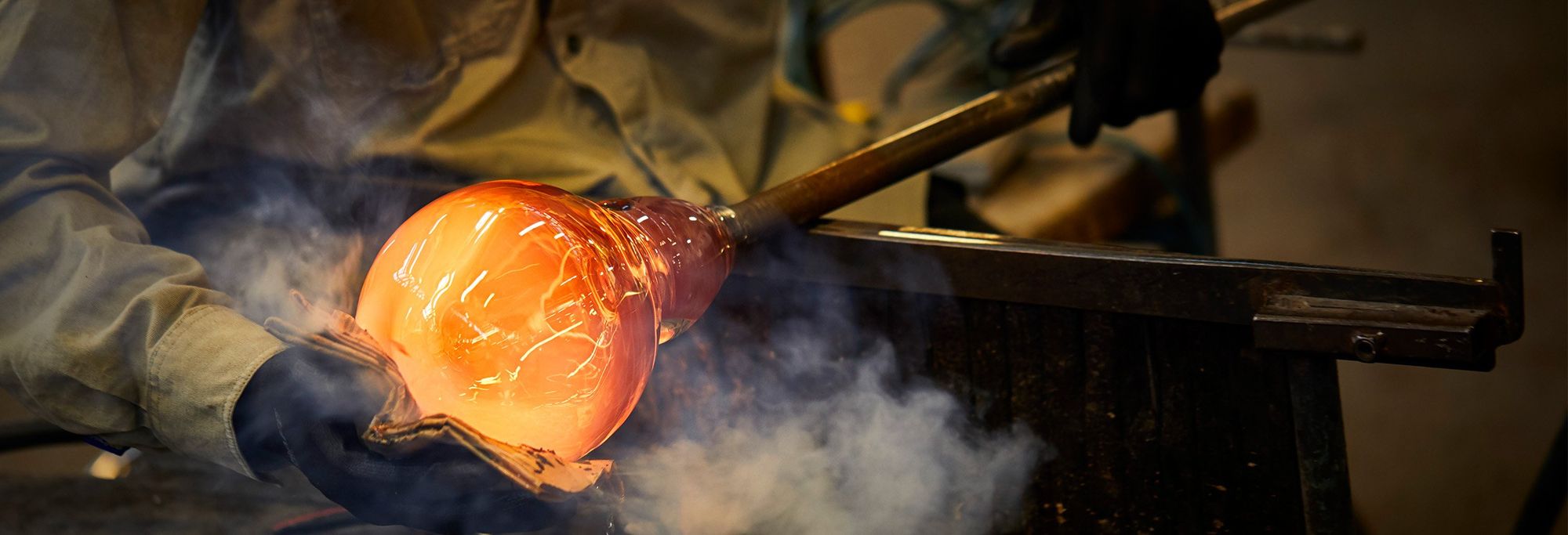
The glittering light of Nordic summer
Devina Solglitter is a creative collaboration between Fagerhult and Orrefors Glasswork. ”I wanted to reflect the glittering light that captures the spirit of Nordic summer”, says designer Lena Bergström.
The Devina collection is based upon a cylindrical shade decorated in 4 distinct design styles, each inspired by the Nordic light in different seasons. For the interpretation of Summer, Fagerhult turned to Orrefors and designer Lena Bergström, one of Sweden’s most renowned designers, specializing in glass and textile.
Orrefors has produced utility glass and art glass made of crystal since 1898. One of Sweden’s famous international design brands, they are associated with timeless Scandinavian elegance, innovative design and genuine craftsmanship. The relationship between Lena Bergström and Orrefors spans over more than two decades and Lena is the designer behind some of the brand’s most beloved glassware like the ”Carat” and the ”Planets” collections.
ALL THAT GLITTERS
The inspiration was found in her own hometown, Umeå in northern Sweden.
”The light you experience in the north of Sweden during the summertime is unique. Umeå is known and loved for its numerous birch trees and I wanted to recreate the experience of the sunlight finding its way through the pergola of delicate leafs”, says Lena.
”You’ll have the same experience if spending a day at sea in northern Scandinavia. The horizon seems incredibly high and the sun reflects itself in the water, creating a wonderful glittering light. My own memories of the sun playing in the water and the light sparkling through the foliage – that’s the light I wanted for Devina.”
A KALEIDOSCOPE
Lena and Fagerhult decided for a cut technique inspired by her Carat glassware, enhancing the contrast between the intricate irregularities of the glass and the luminaire’s, plain smooth metal body.
”It has been a tight collaboration with Fagerhult’s development team and Orrefors’ skilled glass cutters. Glass is a fantastic material to mediate light, but it also comes with a lot of challenges. You have to consider the light distribution and ergonomics without compromising on the energy efficiency of the LED light source”, Lena explains.
She started to experiment with different types of cuts, spending a lot of time in the workshop, side by side with the master-cutter.
”At first, the light distribution didn’t come out well at all. It felt more like stains of light. After some trials and errors, spreading the cuts and adjusting the cutting angle we thought we found the right balance. The testing of the prototypes in Fagerhult’s laboratory proved us right! The final result projects that glittering, comfortable Nordic light that inspired me. It's a bit like a kaleidoscope of Nordic light.”
The brief from Fagerhult was presented with exact details of its application. Lena’s design would be housed within the golden ratio-inspired, cylindrical shape that is mutual for all luminaires in the Devina collection.
”To me it was no obstacle, I’m used working this way. I had to take the complete luminaire with the light engine, the housing and the post into account, to make sure that my design correlated to the other components and materials, but I still felt totally free in the process.”
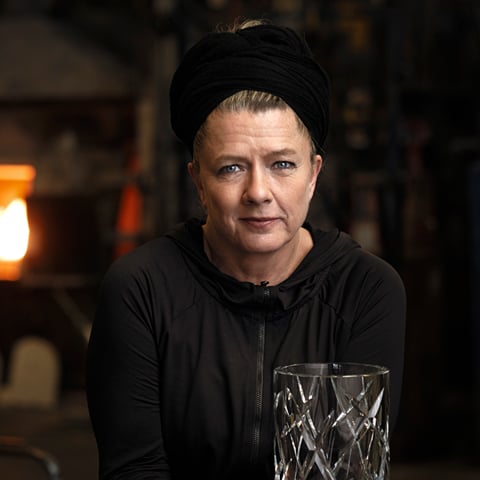 "My own memories of the sun playing in the water and the light sparkling through the foliage – that’s the light I wanted for Devina.” Lena Bergström, designer Orrefors
"My own memories of the sun playing in the water and the light sparkling through the foliage – that’s the light I wanted for Devina.” Lena Bergström, designer Orrefors
HANDCRAFTED IN SWEDEN
Devina Solglitter shade will be hand-produced by the glass cutters at Orrefors’ workshop in Kosta Boda. It embodies a long tradition of craftsmanship, each and every piece unique.
”I like the thought of the collaboration between Fagerhult and Orrefors also being a tribute to Swedish industrial tradition. For a long time Swedish glassworks produced shades for the lighting industry and during the 50’s, 60’s and 70’s the glassworks even had their own luminaire collections. Light is essential to both of us.”
TEXT AMELIE BERGMAN
PHOTO PATRIK SVEDBERG
Related News

La oficina flexible con una nueva luz: el innovador diseño de la iluminación del futuro
La oficina es un lugar en constante cambio, e independientemente del aspecto del diseño, el mobiliario y las operaciones, la iluminación es una parte importante del entorno de trabajo. Sin embargo, el camino hacia una buena luz puede ser sinuoso e ineficiente, y muchos factores deben conjugarse a lo largo del proceso de construcción a través de propietarios, diseñadores de interiores y planificación de la iluminación. Con el sistema de carril Control Track Versa de Fagerhult, la oficina flexible está dando un paso significativo hacia una iluminación más sostenible y flexible. Cecilia Niva es directora de productos y ha impulsado el desarrollo del sistema. El objetivo ha sido dejar que la iluminación del futuro para oficinas innovadoras tome forma, y ahora aparecen nuevas posibilidades circulares. «El carril doble proporciona una libertad completamente nueva en torno al diseño de la iluminación y permite que la luz siga los deseos y necesidades de los inquilinos. Puede combinar fácilmente luz directa e indirecta y alcanzar los 300 lux con solo iluminación ascendente. El carril proporciona el nivel básico adecuado, totalmente independiente de las luminarias, así como más soluciones de control. Por ejemplo, puede tener luces ascendentes comunes que se encienden cuando alguien está en la habitación, mientras que la luz directa en el lugar de trabajo solo se enciende cuando alguien se sienta en él», afirma Cecilia Niva. Cecilia citat Hoy en día, muchas luminarias se descartan antes de que el inquilino se haya mudado porque el propietario de la propiedad desea completar las instalaciones al mismo tiempo que el inquilino está encantado de planificar o cambiar la iluminación y el diseño de interiores en una etapa posterior. Control Track Versa se basa en un sistema de 230V, lo que significa que cada luminaria tiene su propio controlador. Por lo tanto, el sistema puede crecer y cambiar con las necesidades del negocio, y las luminarias pueden reutilizarse de una manera completamente nueva. «Sabemos que muchas personas lo han pedido y lo apreciarán. Nuestro objetivo siempre ha sido crear un sistema de seguimiento que separe la infraestructura y las luminarias y que haga que la instalación y el uso sean independientes entre sí. Esto proporciona beneficios tanto de cara a la sostenibilidad como a la flexibilidad», continúa Cecilia Niva. Flex office block FAGERHULT PRODUCTION OFFICE Una mayor flexibilidad también viene acompañada de un uso más eficiente de las luminarias. Gracias a su facilidad de manejo y versatilidad, cada luminaria se puede mover, adaptar y reutilizar repetidamente durante todo su ciclo de vida. «El uso a largo plazo afecta positivamente a la sostenibilidad a lo largo del tiempo y a medida que el negocio y el mobiliario cambian. También crea un excelente espacio creativo para diseñadores de iluminación, arquitectos y diseñadores de interiores». Creatividad y flexibilidad Durante el desarrollo de Control Track Versa, uno de los objetivos ha sido facilitar a los diseñadores de iluminación, arquitectos y diseñadores de interiores la planificación de la iluminación y la creación de entornos de alta calidad. El sistema de carriles puede describirse como una caja de herramientas para la iluminación, ya que cada componente de la iluminación es independiente y puede crear entornos de iluminación y efectos de manera más flexible. La luminaria VIL hace que las luces ascendentes y descendentes sean completamente independientes entre sí, ya que se pueden montar a lo largo de filas enteras, lo que proporciona un techo iluminado de manera uniforme en las zonas deseadas. A diferencia de un sistema de 48 V, no se necesitan cálculos nuevos cuando se añaden o mueven luminarias a lo largo del carril. «En cierto modo, el carril se convierte en su propia infraestructura, ofreciendo infinitas combinaciones y gran flexibilidad. Proporciona nuevas oportunidades para combinar fácilmente la luz directa e indirecta sin una amplia planificación de la iluminación ni decisiones importantes antes de que el inquilino se mude. También facilita a los propietarios y arrendatarios el mantenimiento, la actualización y la creación de buenos entornos de iluminación con el paso del tiempo», concluye Cecilia Niva.
La oficina del futuro: un lugar de cambio
Iluminar las oficinas ha sido una tarea bastante sencilla durante mucho tiempo. Soluciones de referencia con baldosas de 60x60, cálculos probados y un resultado de luz homogénea y general. La ventaja es que todos pueden moverse y sentarse en cualquier lugar, con el resultado de que la luz no es buena para nadie. A medida que cambia la forma en que diseñamos y utilizamos la oficina, surgen nuevas necesidades con respecto a la iluminación. La oficina es un lugar para trabajar, celebrar reuniones, colaborar y crear. Sigue el desarrollo del negocio y los cambios entre los empleados. Al mismo tiempo, el entorno de trabajo general en Suecia está regulado por las recomendaciones de la Autoridad Sueca del Entorno de Trabajo, y la iluminación a menudo se diseña de acuerdo con patrones establecidos. Henrik Clausen dirige la Fagerhult Lighting Academy y cree que tanto las empresas como los empleados se sienten bien si la oficina es un entorno agradable, y la iluminación contribuye a ello. La luz correcta también afecta a muchos, pero a pesar de eso, las personas a menudo toman el atajo para lograr los requisitos del entorno de trabajo. «No digo que las baldosas de 60x60 sean malas. Pero tampoco son buenas, ya que los locales adquieren el ambiente de un día lluvioso. Con flujos bien pensados y la iluminación adecuada, podemos crear un entorno luminoso que se asemeja a la luz natural y varía entre las diferentes partes de la oficina, y entonces nos sentiremos mejor», dice Henrik Clausen. Quote Henrik Clausen Pero antes de que una oficina esté lista para la ocupación, son muchas las piezas que tienen que encajar en su sitio, y la iluminación es una de ellas. Lisa Sandvik es gestora de proyectos en Tenant and Partner en Gotemburgo y trabaja en el desarrollo de inmuebles sostenibles y que crean valor con un enfoque en las oficinas: «Cuando cambiamos de oficina y conseguimos una buena iluminación, quedó claro la contribución que hace al entorno de trabajo. Hoy en día, junto con los arquitectos, nos gusta plantear el problema de la iluminación a los propietarios en una etapa mucho más temprana e intentar sacarlos más de su zona de confort» dice Lisa Sandvik. Flexible office bildcollage artikel 1 FAGERHULT PRODUCTION OFFICE Al mismo tiempo, los propietarios suelen estar muy lejos en su diseño y sus procesos de adquisición y planificación son los que mandan. Si los costes son demasiado altos, a menudo se conforman con cambiar la iluminación en una zona o un par de habitaciones. «Tenemos muy pocos conocimientos sobre la luz, algo que llama la atención cuando la necesitamos tanto. Los empleados y las personas, así como los propietarios, saben muy poco sobre cómo nos afectan la luz y los contrastes en la vida cotidiana, y no menos importante en el lugar de trabajo. En esto necesitamos aprender más juntos y mejorar en la búsqueda de los argumentos correctos y los productos adecuados para presentárselos a los propietarios», dice Lisa Sandvik. Quote Lisa Sandvik Todos los proyectos que impliquen oficinas se basan en las recomendaciones y directivas de la Autoridad Sueca del Entorno Laboral. Pero a menudo es difícil demostrar el valor de la buena luz. «Los socios como nosotros y los arquitectos pueden transmitir con mayor claridad a los inquilinos los efectos que puede tener una buena iluminación. Al mismo tiempo, me gustaría ver a los propietarios dar un paso adelante en el deseo de ofrecer lugares de trabajo prósperos y que funcionen bien. Necesitamos saber más sobre la luz en Escandinavia. La tenemos tanto con nosotros como contra nosotros», dice Lisa Sandvik. Una tendencia que hoy en día vemos en Tenant and Partner es que los empleadores más grandes abogan por que los empleados estén en la oficina durante una mayor parte de la semana laboral. Las encuestas muestran que la gente quiere poder trabajar sin problemas y concentrado. «Vemos una mayor necesidad de salas de concentración y lugares de trabajo tranquilos con buena tecnología y la ergonomía adecuada. Los espacios compartidos son, por supuesto, aún necesarios, pero sobre todo, uno quiere poder trabajar centrado y sin interrupciones de la misma manera que puede hacerlo en casa. Por lo tanto, la oficina debe ser un entorno en el que nuestros empleados se sientan cómodos, se sientan bien y sean productivos, y la iluminación es un factor importante allí», concluye Lisa Sandvik.

